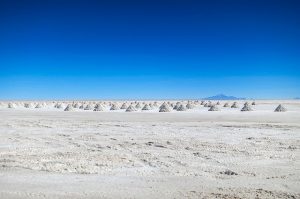 12/01/2021
12/01/2021
[resumen.cl] La gran minería se refiere como «Triángulo del Litio» a la zona que alberga entre un 70% y 85% de las reservas de litio descubiertas, siendo objeto de la explotación extractivista y escenario de conflictos socioambientales que van en auge sostenido tras el impacto negativo en los ecosistemas de la zona altoandina de Chile, Bolivia y Argentina.
Desde hace años que se ha instalado en el debate público el impacto multidimensional del extractivismo como modelo que acompaña, en América Latina, el desarrollo del neoliberalismo. La minería, la industria forestal y el rubro de la energía han sido identificadas como piedras angulares, a escala regional, de los sectores alimentados de la extracción de recursos naturales, trayendo consigo consecuencias para el medioambiente y las comunidades que habitan los territorios.
En este contexto, por su capacidad de densidad eléctrica, el litio ha sido caracterizado como un metal que presenta un buen almacenamiento de electricidad y, a la vez, de calor, concibiéndose como ‘el oro blanco del siglo XXI’, siendo esencial para la fabricación de cerámicas, lubricantes y siendo utilizado en la metalurgia. Asimismo, en consideración del contexto de traspaso de los combustibles fósiles a las denominadas ‘energías renovables’, el litio es utilizado para la fabricación de baterías de dispositivos como computadores, celulares e, incluso, de autos eléctricos.
Así, la explotación del litio ya se encuentra andando en Latinoamérica, teniendo como referencia a Bolivia, Argentina y Chile como países en donde esto ha significado el desarrollo de importantes conflictos sociales, siendo los principales productores de litio ubicados en los salares altoandinos del Cono Sur, pese a existir otros países como Australia, Congo, España, México y Canadá que también cuentan con importantes reservas de litio.
Conflicto triangulado: medioambiente, extractivismo y resistencia(s)
La codicia extractivista y neoliberal del litio se ha traducido en lo que se conoce como ‘Triángulo’ de los territorios altoandinos de Argentina, Chile y Bolivia, países que cuentan con salares y humedales que están en la mira de grandes empresas a nivel mundial pese a que, como señala el Observatorio de Conflictos Mineros de América Latina (OCMAL) «ser un conjunto de ecosistemas que albergan no solo salares sino también fauna, incluida la micro fauna, flora, y asentamientos humanos».
Según diversos estudios[1], entre un 70% y un 85% de las reservas de litio -descubiertas, explotables y económicamente viables- se encuentran en esta zona. Concretamente, en Bolivia se considera el Salar de Uyuni, en Chile el Salar de Atacama y en Argentina el Salar del norte de Catamarca y de la Puna Jujeña y Salteña, lo cual ha sido objeto de la llamada ‘fiebre del litio’ caracterizada por el auge de la explotación de este elemento.
Este escenario ha significado, a escala regional, el desarrollo de importantes y, en algunos casos, nacientes conflictos basados en la resistencia de las comunidades en defensa de los territorios. En esta línea, mediante una declaración firmada por diversas individualidades y organizaciones, incluido el Observatorio Plurinacional de Salares Andinos, se expresó que la popularización del término ‘Triángulo del Litio’ por las empresas mineras «es un incentivo a la sobrexplotación de este mineral en los salares como commodity estratégico para una transición energética «verde», cuyos costos ambientales y sociales perpetúan la histórica huella del extractivismo en territorios indígenas andinos«.
En este contexto, la investigadora Bárbara Jerez ha señalado que como consecuencias de su explotación ha avanzado la devastación de los territorios, la irrupción en las formas de vidas de comunidades de pueblos originarios y el hecho de que se estén secando acuíferos subterráneos.
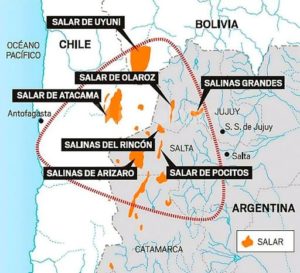 (Fotografía: inspimundo)
(Fotografía: inspimundo)
Te puede interesar| Maricunga: El salar más austral de Chile amenazado por la minería del litio
Así, el impacto en la dinámica hidrológica de, por ejemplo, los salares, no solo se ha desarrollado en base a un desconocimiento -sustentándose en la no existencia de estudios veraces-, sino que también en el auge de los conflictos para con las comunidades a través de la irrupción de empresas en los territorios.
De esta forma, los tres países del Cono Sur son territorios que, geopolíticamente, son objeto de intereses económicos de potencias extranjeras y el empresariado nacional que han procedido a la explotación del litio sustentándose en la continuación y anclaje del extractivismo, es decir, con bajo procesamiento y con altos impactos socioambientales y culturales.
Sin embargo, el ‘Triángulo’ cuenta con características administrativas particulares. En el caso de Bolivia el litio es manejado en un 100% mediante propiedad estatal, administrada por la Corporación Minera de Bolivia (COMIBOL), la cual se asoció con la empresa alemana K-Utec Technology con la intención de crear el diseño ingenieril de la planta en el Salar de Uyuni.
Paralelamente, en el caso de Argentina los permisos de exploración y explotación del litio varían su propiedad acorde a las provincias, sin regularizar ni restringir la cantidad de agua que se puede extraer de los salares como tampoco la cantidad de litio, siendo explotado por empresas nacionales y transnacionales.
Por su parte, en Chile se encuentra declarado como propiedad exclusiva del Estado sustentado en tres instituciones: Corporación del Cobre (CODELCO), Corporación de Fomento de la Producción (CORFO) y la Empresa nacional de Minería (ENAMI), las cuales entregan los contratos de arrendamiento o de operación del litio, donde, como empresas que resuenan en su explotación, se encuentran Soquimich (SQM), Albemarle (minera norteamericana), la propia CODELCO que podrá iniciar exploraciones, Wealth minerals (empresa canadiense), entre otras.
En este escenario, el litio ha sido declarado en el país como un mineral no concesible, lo cual se relaciona con el interés de uso nuclear que existe sobre el metal, por lo que su extracción y sus concentrados derivados o compuestos están supeditados a la aprobación de la Comisión Chile de Energía Nuclear.
Derechos de la naturaleza y conflicto socioambiental
El auge sostenido de los conflictos socioambientales en la región latinoamericana no se ha obviado en el caso del litio, más aún cuando la naturaleza se ha instalado como un sujeto de derechos.
Sin embargo, pese a los antecedentes y progresivos estudios e investigaciones que se publican, en general se desconoce la cara oscura del litio, la cual implica la destrucción de humedales altoandinos, la utilización masiva de agua en zonas con alta escasez hídrica y el impacto a las comunidades indígenas andinas en los tres países del Cono Sur.
En este contexto, el litio para el sur de América Latina comienza a ser un tema altamente importante para las economías de Chile, Argentina, Bolivia y, por consiguiente, del mercado transnacional, trayendo impactos socioambientales aún poco conocidos y difundidos, a la vez que concentra la riqueza en manos de pocos grupos multinacionales que reproducen la intensa desigualdad que históricamente ha existido en el continente.
https://resumen.cl/articulos/la-ambicion-minera-por-el-codiciado-triangulo-del-litio-en-chile-bolivia-y-argentina
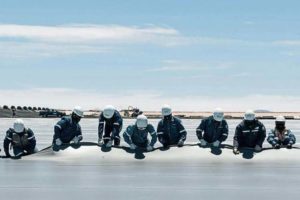 La Paz, 11/01/2021 (Prensa Latina)
La Paz, 11/01/2021 (Prensa Latina)


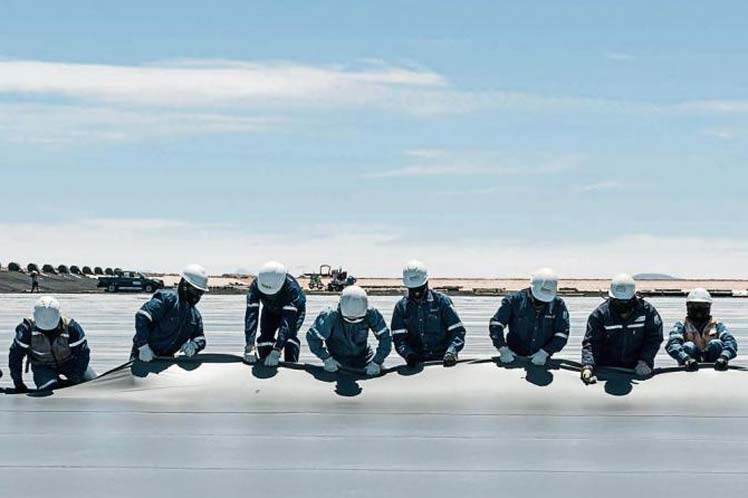
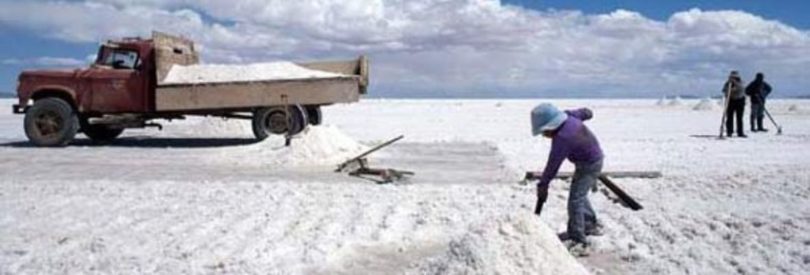
 12/01/2021
12/01/2021 (Fotografía: inspimundo)
(Fotografía: inspimundo)
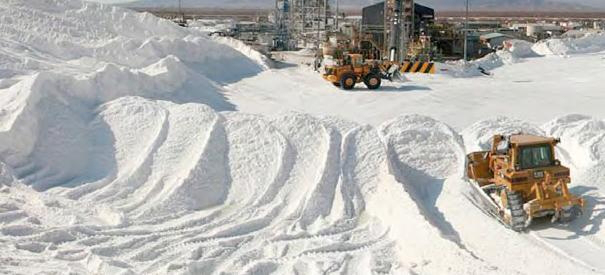
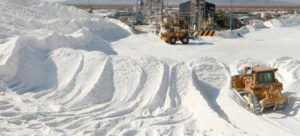 12/01/2021
12/01/2021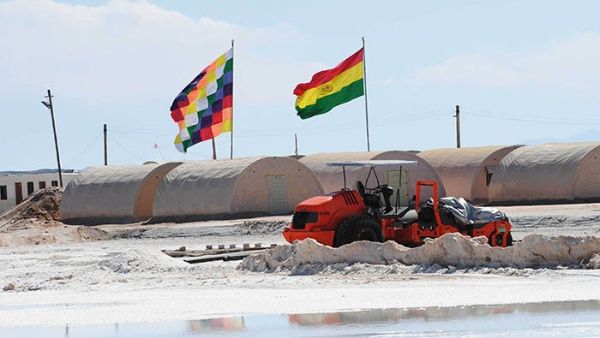
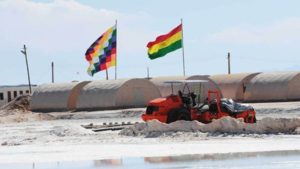 Los yacimientos de litio de Bolivia están entre los más grandes del mundo. | Foto: ABI
Los yacimientos de litio de Bolivia están entre los más grandes del mundo. | Foto: ABI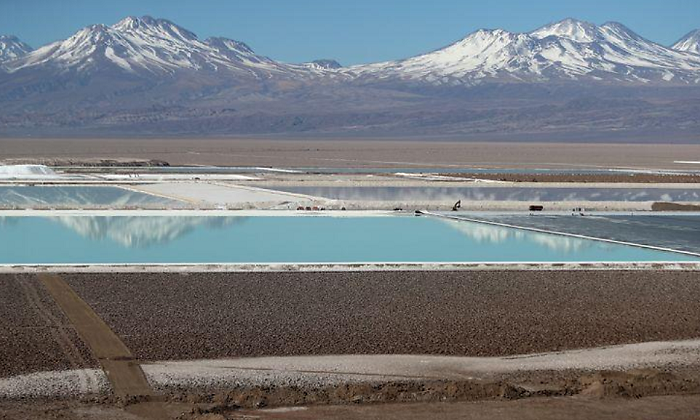
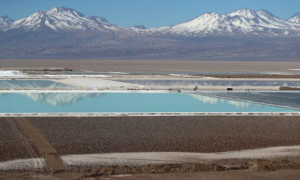 Piscinas de salmuera de la productora de litio estadounidense Albemarle en el salar de Atacama. Foto: Reuters/Iván Alvarado/Archivo
Piscinas de salmuera de la productora de litio estadounidense Albemarle en el salar de Atacama. Foto: Reuters/Iván Alvarado/Archivo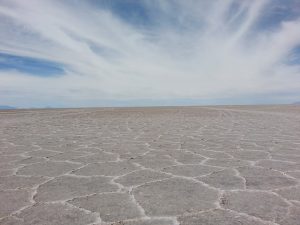
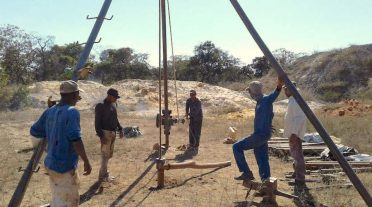
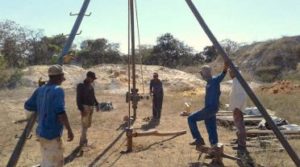 04/01/2021 2021
04/01/2021 2021